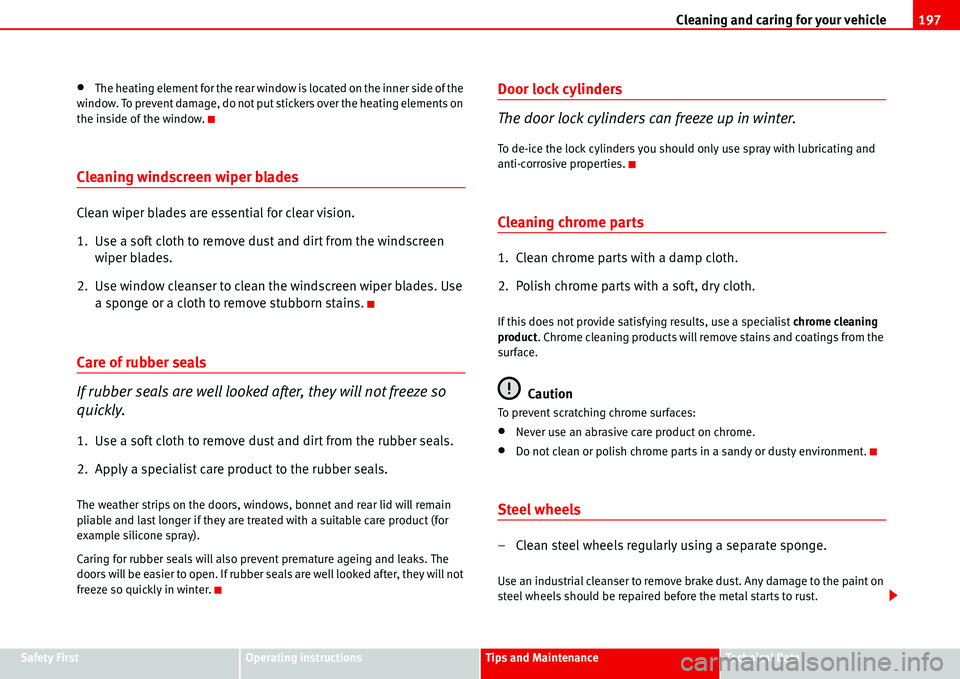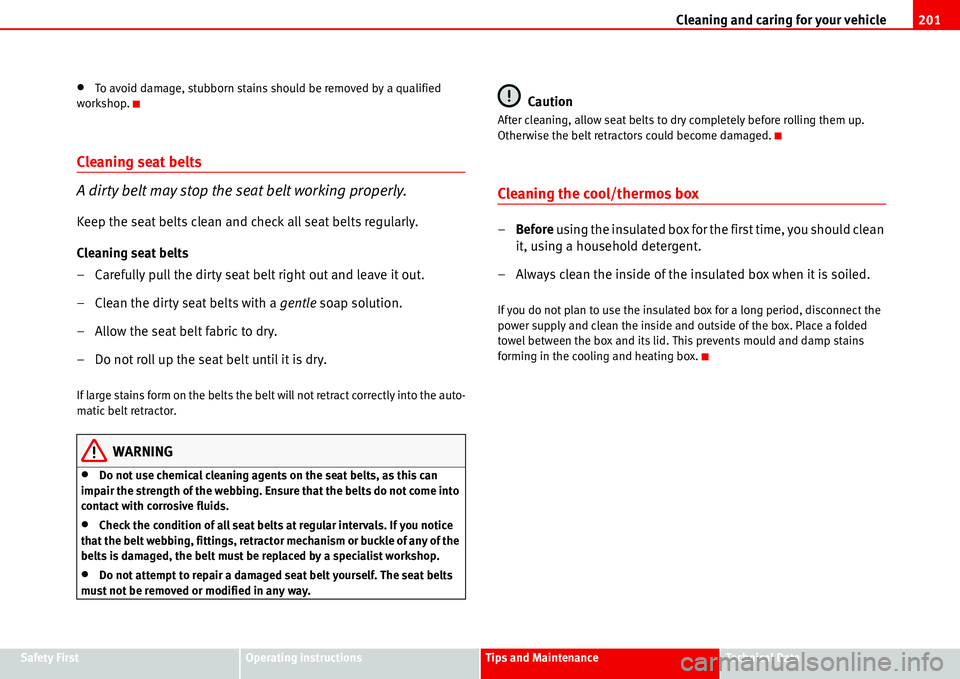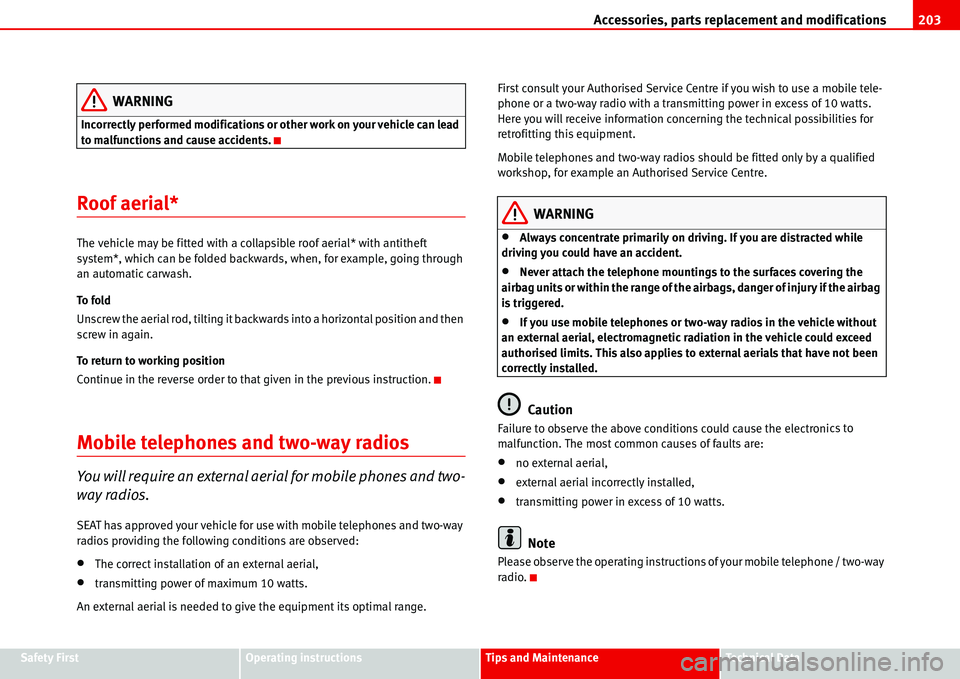2006 Seat Alhambra maintenance
[x] Cancel search: maintenancePage 193 of 299

Driving and the environment191
Safety FirstOperating instructionsTips and MaintenanceTe c h n i c a l D a t a Overheating
At very high temperatures and during prolonged ascents, driving in a low gear
and high engine speed always monitor the temperature indicator for the
coolant.
Electronic Stabilisation Program
Do not switch off the ESP when towing a trailer. The ESP makes it easier to
stabilise if the trailer starts to snake.
Driving economically and with respect for the
environment
General notes
Fuel consumption depends largely on your personal driving
style.
Fuel economy, environmental impact and wear on the engine, brakes and
tyres depend largely on three factors:
•Personal driving style
•Conditions of use (weather, road surface)
•Technical requirements
By adopting an economical driving style and anticipating the traffic situation
ahead, you can easily reduce fuel consumption by 10-15%. This section
suggests methods of lessening the impact on the environment and reducing
your operating costs at the same time.
Think ahead when driving
A vehicle uses most fuel when accelerating. If you think ahead when driving,
you will need to brake less and thus accelerate less. Wherever possible, let
the vehicle roll slowly to a stop, for instance when you can see that the next
traffic lights are red.
Regular servicing
By taking your car to an Authorised Service Centre for regular servicing you
can establish a basis for good fuel economy before you start driving. A well-
serviced engine gives you the benefit of improved fuel efficiency as well as
maximum reliability and an enhanced resale value.
A badly serviced engine can consume up to 10% more fuel than necessary.
Check the oil level every time you fill the tank. Oil consumption depends to a
great extent on the engine load and engine speed. Depending on your
personal driving style, oil consumption can be up to 1 litre per 1,000 km.
Page 195 of 299

Cleaning and caring for your vehicle193
Safety FirstOperating instructionsTips and MaintenanceTe c h n i c a l D a t a
Cleaning and caring for your vehicle
General notes
Regular washing and care help maintain the value of your
vehicle.
Regular care
Regular and expert care helps to maintain the value of the vehicle. This may
also be one of the requirements for acknowledging warranty claims in the
event of corrosion or paint defects.
The best way to protect the car against environmental contaminants is to
wash and wax it frequently. The longer substances such as insects, bird drop-
pings, resinous tree sap, road dirt, industrial deposits, tar, soot or road salt
and other aggressive materials remain on the vehicle, the more damage they
do to the paintwork. High temperatures (for instance in strong sunlight)
further intensify the corrosive effect.
After the period when salt is put on the roads it is important to have the
underside of the vehicle washed thoroughly.
Car care products
Car care products are available from your Authorised Service Centre. Keep the
product instructions until you have used up the product.
WARNING
•Car care products can be toxic. For this, they must always be kept
closed in their original container. Keep out of children's reach. Failure to
comply could result in poisoning.
•Always read and observe the instructions and warnings on the package
before using car care products. Improper use could damage your health or your vehicle. The use of certain products may produce noxious vapours;
these should be used in well-ventilated areas.
•Never use fuel, turpentine, engine oil, nail varnish remover or other
volatile fluids. These are toxic and highly flammable. There is a fire / explo-
sion risk.
•Before you wash your vehicle, or carry out any maintenance, switch off
the engine, apply the handbrake firmly and remove the key from the igni-
tion.
Caution
Never attempt to remove dirt, mud or dust if the surface of the vehicle is dry.
Never use a dry cloth or sponge for cleaning purposes. This could damage the
paintwork or glass on your vehicle. Soak dirt, mud or dust with plenty of
water.
For the sake of the environment
•When purchasing car care products, try to select ones which are not
harmful to the environment.
•Left over car care products should not be disposed of with ordinary house-
hold waste. Observe the disposal information on the package.
WARNING (continued)
Page 197 of 299

Cleaning and caring for your vehicle195
Safety FirstOperating instructionsTips and MaintenanceTe c h n i c a l D a t a
For the sake of the environment
In the interests of environmental protection, the car should be washed only
in specially provided wash bays. This prevents toxic, oil-laden waste water
entering the sewerage system. In some districts, washing vehicles anywhere
else may be prohibited.
Note
Do not wash the vehicle in direct sunlight.
Washing the car with a high pressure cleaner
Be particularly careful when using a high pressure cleaner!
– Always observe the instructions for the high-pressure cleaner,
particularly those concerning the pressure and the spraying
distance.
– Increase the spraying distance for soft materials and painted
bumpers.
– Do not use a high pressure cleaner to remove ice or snow from
windows �Ÿpage 196.
– Never use concentrated jet nozzles or so-called “dirt blasters”
�Ÿ.
– If possible, avoid sudden braking directly after washing the
vehicle. “Dry ” the brakes by applying the brakes carefully
several times
WARNING
•Never wash tyres with a concentrated jet or cylindrical jet (“rotating
nozzle”). Even at large spraying distances and short cleaning times, visible
and invisible damage can occur to the tyres. This may cause an accident.
•Moisture, ice and salt on the brakes may affect braking efficiency. Risk
of accident.
Caution
•Do not use water hotter than 60°C. This could damage the car.
•To avoid damage to the vehicle, maintain a sufficient distance from sensi-
tive materials for example: flexible hoses, plastic, sound proofing, etc. This is
especially important for bumpers painted in the same colour as the vehicle.
The closer the nozzle is to the surface, the greater the wear on the material.
Waxing the car
Regular waxing protects the paintwork.
You need to apply wax to your car if water does not form small drops and run
off the paintwork when it is clean.
Good quality hard wax is available from your Authorised Service Centre.
A good coat of wax helps to protects the paintwork from environmental
contaminants �Ÿpage 193. It is also effective in protecting against minor
scratches.
Even if a wax solution is used regularly in the car wash, it is advisable to
protect the paint with a coat of hard wax at least twice a year.
Page 199 of 299

Cleaning and caring for your vehicle197
Safety FirstOperating instructionsTips and MaintenanceTe c h n i c a l D a t a
•The heating element for the rear window is located on the inner side of the
window. To prevent damage, do not put stickers over the heating elements on
the inside of the window.
Cleaning windscreen wiper blades
Clean wiper blades are essential for clear vision.
1. Use a soft cloth to remove dust and dirt from the windscreen
wiper blades.
2. Use window cleanser to clean the windscreen wiper blades. Use
a sponge or a cloth to remove stubborn stains.
Care of rubber seals
If rubber seals are well looked after, they will not freeze so
quickly.
1. Use a soft cloth to remove dust and dirt from the rubber seals.
2. Apply a specialist care product to the rubber seals.
The weather strips on the doors, windows, bonnet and rear lid will remain
pliable and last longer if they are treated with a suitable care product (for
example silicone spray).
Caring for rubber seals will also prevent premature ageing and leaks. The
doors will be easier to open. If rubber seals are well looked after, they will not
freeze so quickly in winter.
Door lock cylinders
The door lock cylinders can freeze up in winter.
To de-ice the lock cylinders you should only use spray with lubricating and
anti-corrosive properties.
Cleaning chrome parts
1. Clean chrome parts with a damp cloth.
2. Polish chrome parts with a soft, dry cloth.
If this does not provide satisfying results, use a specialist chrome cleaning
product. Chrome cleaning products will remove stains and coatings from the
surface.
Caution
To prevent scratching chrome surfaces:
•Never use an abrasive care product on chrome.
•Do not clean or polish chrome parts in a sandy or dusty environment.
Steel wheels
– Clean steel wheels regularly using a separate sponge.
Use an industrial cleanser to remove brake dust. Any damage to the paint on
steel wheels should be repaired before the metal starts to rust.
Page 201 of 299

Cleaning and caring for your vehicle199
Safety FirstOperating instructionsTips and MaintenanceTe c h n i c a l D a t a
Cleaning the engine compartment
Take special care when cleaning the engine compartment.
Anti-corrosion treatment
The engine compartment and the surface of the power unit are given anti-
corrosion treatment at the factory.
Good corrosion protection is particularly important in winter when the car is
frequently driven on salted roads. To prevent the salt corroding the vehicle,
the entire engine compartment should be thoroughly cleaned before and
after the salting period.
Your Authorised Service Centre is able to provide the correct cleaning and
preserving products and has the necessary equipment. For this reason, we
recommend having this work performed by them.
The anti-corrosion protection is usually removed if the engine compartment
is cleaned with grease removing solutions, or if you have the engine cleaned.
If this job is carried out, you should ensure that all surfaces, seams, joints and
components in the engine compartment are given anti-corrosion treatment
afterwards.
WARNING
•When working in the engine compartment, always observe the safety
warnings �Ÿpage 209
•Switch off the engine, apply the parking brake firmly and always
remove the key from the ignition before you open the bonnet.
•Allow the engine to cool before you clean the engine compartment.
•Do not clean the underside of vehicle, wheel arches without protecting
your hands and arms. You may cut yourself on sharp-edged metal parts.
Failure to comply could result in injury.
•Moisture, ice and salt on the brakes may affect braking efficiency. Risk
of accident. If possible, avoid sudden braking immediately after washing
the vehicle.
•Never touch the radiator fan. It is temperature-controlled and could
start automatically, even when the key is removed from the ignition!
For the sake of the environment
Fuel, grease and oil deposits could be removed when the engine is washed.
The polluted water must be cleaned in an oil separator. For this reason,
engine washing should be carried out only by a qualified workshop or a suit-
able filling station.
Care of the vehicle interior
Cleaning plastic parts and the dash panel
– Use a clean, damp cloth to clean plastic parts and the dash
panel.
– If this does not provide satisfactory results, use a special
solvent-free plastic cleaning product.
WARNING
Never clean the dash panel and surface of the airbag module with cleansers
containing solvents. Solvents cause the surface to become porous. If the
airbag inflates, disintegrating plastic parts can cause substantial injuries.
WARNING (continued)
Page 203 of 299

Cleaning and caring for your vehicle201
Safety FirstOperating instructionsTips and MaintenanceTe c h n i c a l D a t a
•To avoid damage, stubborn stains should be removed by a qualified
workshop.
Cleaning seat belts
A dirty belt may stop the seat belt working properly.
Keep the seat belts clean and check all seat belts regularly.
Cleaning seat belts
– Carefully pull the dirty seat belt right out and leave it out.
– Clean the dirty seat belts with a gentle soap solution.
– Allow the seat belt fabric to dry.
– Do not roll up the seat belt until it is dry.
If large stains form on the belts the belt will not retract correctly into the auto-
matic belt retractor.
WARNING
•Do not use chemical cleaning agents on the seat belts, as this can
impair the strength of the webbing. Ensure that the belts do not come into
contact with corrosive fluids.
•Check the condition of all seat belts at regular intervals. If you notice
that the belt webbing, fittings, retractor mechanism or buckle of any of the
belts is damaged, the belt must be replaced by a specialist workshop.
•Do not attempt to repair a damaged seat belt yourself. The seat belts
must not be removed or modified in any way.
Caution
After cleaning, allow seat belts to dry completely before rolling them up.
Otherwise the belt retractors could become damaged.
Cleaning the cool/thermos box
–Before using the insulated box for the first time, you should clean
it, using a household detergent.
– Always clean the inside of the insulated box when it is soiled.
If you do not plan to use the insulated box for a long period, disconnect the
power supply and clean the inside and outside of the box. Place a folded
towel between the box and its lid. This prevents mould and damp stains
forming in the cooling and heating box.
Page 205 of 299

Accessories, parts replacement and modifications203
Safety FirstOperating instructionsTips and MaintenanceTe c h n i c a l D a t a
WARNING
Incorrectly performed modifications or other work on your vehicle can lead
to malfunctions and cause accidents.
Roof aerial*
The vehicle may be fitted with a collapsible roof aerial* with antitheft
system*, which can be folded backwards, when, for example, going through
an automatic carwash.
To f o l d
Unscrew the aerial rod, tilting it backwards into a horizontal position and then
screw in again.
To return to working position
Continue in the reverse order to that given in the previous instruction.
Mobile telephones and two-way radios
You will require an external aerial for mobile phones and two-
way radios.
SEAT has approved your vehicle for use with mobile telephones and two-way
radios providing the following conditions are observed:
•The correct installation of an external aerial,
•transmitting power of maximum 10 watts.
An external aerial is needed to give the equipment its optimal range.First consult your Authorised Service Centre if you wish to use a mobile tele-
phone or a two-way radio with a transmitting power in excess of 10 watts.
Here you will receive information concerning the technical possibilities for
retrofitting this equipment.
Mobile telephones and two-way radios should be fitted only by a qualified
workshop, for example an Authorised Service Centre.
WARNING
•Always concentrate primarily on driving. If you are distracted while
driving you could have an accident.
•Never attach the telephone mountings to the surfaces covering the
airbag units or within the range of the airbags, danger of injury if the airbag
is triggered.
•If you use mobile telephones or two-way radios in the vehicle without
an external aerial, electromagnetic radiation in the vehicle could exceed
authorised limits. This also applies to external aerials that have not been
correctly installed.
Caution
Failure to observe the above conditions could cause the electronics to
malfunction. The most common causes of faults are:
•no external aerial,
•external aerial incorrectly installed,
•transmitting power in excess of 10 watts.
Note
Please observe the operating instructions of your mobile telephone / two-way
radio.
Page 207 of 299

Accessories, parts replacement and modifications205
Safety FirstOperating instructionsTips and MaintenanceTe c h n i c a l D a t a If a towing bracket is to be retro-fitted to the car, it must be done according to
the instructions of the towing bracket manufacturer.
The attachment points for the towing bracket �Ÿpage 204, fig. 137 are
underneath the vehicle.
Always observe the minimum distance from the middle of the ball coupling to
the ground (350 to 420 mm). This also applies when the vehicle is fully laden,
including maximum drawbar load.
Fitting a towing bracket
•Driving with a trailer implies additional work for the vehicle. Therefore,
before fitting a towing bracket, please contact an Authorised Service Centre
to check whether your cooling system needs modification.
•Observe the legal requirements in your country (e. g. the fitting of a sepa-
rate pilot lamp).
•Certain vehicle components, e.g. the rear bumper must be removed and
reinstalled. The towing bracket securing bolts have to be tightened using a
torque wrench, and a socket connected to the vehicle's electrical system .
This requires specialist knowledge and tools.
•The figures in the illustration show the dimensions and attachment points
which must be observed if you are retrofitting a towing bracket.
WARNING
If a towing bracket is retrofitted, it should be done by a qualified dealer.
•If the towing bracket is incorrectly fitted, this could cause a safety risk.
•For your own safety, please observe the instructions provided by the
manufacturer of the towing bracket.
Caution
If the connector socket is not fitted correctly, this could cause damage to the
vehicle's electrical system.
AA